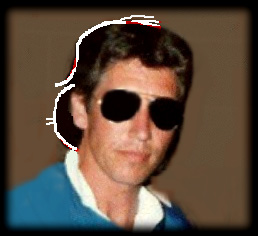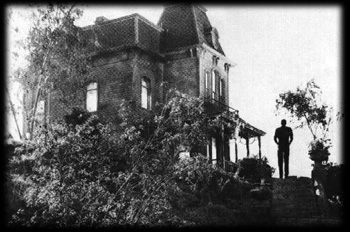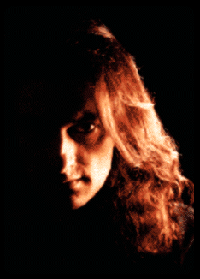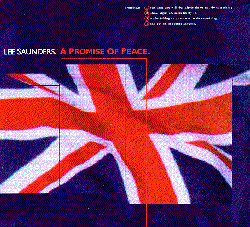|
Is It Possible That Waters Was Influenced By The Master of Suspense, Alfred Hitchcock? Some Interesting Parallels and Coincidences to Ponder. By Mark Brown
The Wrong Man is a 1956 Alfred Hitchcock movie based on the true story of a musician named Manny Balestrero. He was played by Henry Fonda as a poor-but-honest family man who was jailed and brought to trial for robbery in a tragic case of mistaken identity. Everything went wrong for poor Manny and his wife Rose, played by Vera Miles, when they tried to establish his alibi. She suffered a serious emotional breakdown because of the stress, somehow coming to believe it was all her fault. She was quite disconsolate -- in effect asking the question "Have I been guilty all this time?" In the movie, Rose's psychiatrist explained to Manny that her mind was "in an eclipse." He said that she was "living in another world from ours... a frightening landscape that could be on the dark side of the moon." It seems like an extraordinary coincidence to me, and I wonder if it had a direct effect on the titles chosen by Roger Waters for an album about the stresses of life. Roger could have seen it at age 12 or 13. Can he have remembered it, even if only subconsciously? Can it have influenced his thoughts about madness and paranoia on Dark Side, perhaps even on The Wall? Was the unfair trial of a musician something that was still in the back of Roger's mind when he created the plot of The Wall? I think it might be so. The Wrong Man seems to be the type of movie Roger likes, and he does remember movies he saw when he was about that age. I found this comment by Roger about an Italian film that showed the tragic effect of war on common people: "I remember seeing The Bicycle Thief--I can't have been more than 11 or 12 years old--and I remember being moved to tears by that movie. [Movies like that move me because] they're real stories with real beginnings and middles and ends about people's real feelings. I need to be involved with the characters, and they can't be shallow..." He emphasized: "They have to be real people that things happen to." Hitchcock, in his most elaborate cameo appearance, addresses the audience at the beginning of The Wrong Man to stress that the story is factual, unlike his usual offerings. The credits also say it emphatically. The film goes to great lengths to help viewers identify with Manny's predicament, for example by dwelling on the details of police procedure. Similarly, the scenes chosen to tell the story create strong empathy for the guilt-ridden Rose Balestrero. Hitchcock even cast Rose's actual psychiatrist to play himself. Now, some coincidences are barely remarkable, and little should be made of them. For example, Manny Balestrero played a bass, but it wasn't a bass guitar. Roger used the names Vera and Rose in his lyrics for The Wall and Amused to Death but those names are well explained without thinking of Rose Balestrero played by Vera Miles. Other coincidences are intriguing, but don't necessarily indicate anything significant. Still, it can be amusing to speculate about coincidences. Look at these similarities between Roger Waters and Alfred Hitchcock, and compare their works. Both are English, and worked in London and Hollywood. Both are famous for portraying the dark side of human nature. Both are also known for dry humor, black humor, and macabre humor. Both created characters who were emotionally damaged by overprotective mothers, ones who went from passivity to sudden violence: Pink in The Wall and Norman Bates in Psycho. Both have used particular sounds for dramatic and suspenseful effect: "Careful With That Axe, Eugene" and Psycho are punctuated with screams, and eerie bird calls in "Echoes" are reminiscent of The Birds. There's some similarity in their use of a buzzing insect at the ends of both "Grantchester Meadows" and Psycho to add a sense of foreboding to an outwardly calm moment.
Look at this comment by film critic David Sterrit: "The Wrong Man... focuses on some of Hitchcock's most deeply felt personal obsessions, particularly his persistent guilt feelings and his dread of police and authority figures... [its protagonist is] a man in conflict not only with his inner self but also with the society around him... Especially revealing in these conflicts is the evidence they provide of sado-masochistic tendencies in the protagonist's mentality... suggesting a willfully endured alienation... Also relevant to this theme are the film's view of family life as an inadequate yet compulsively-embraced haven from a disordered and untrustworthy world..." Wow! That could just as well have been written about Waters and The Wall! Mark Brown is a guest contributor to Spare Bricks
A Floyd Fan's Introduction To Lee Saunders By Mike McInnis
That said, Lee Saunders is an artist of whom any fans of late-Waters-era Pink Floyd and Waters' solo work should definitely sit up and take notice. Though Saunders' lone release, 1995's A Promise Of Peace, has thus far failed to make much impact on the music scene, it seems only a matter of time before somebody somewhere figures out what a powerful message this 39-year-old Englishman is trying to share. Telling the story of World War II from a decidedly English point of view, the album is essentially a 77-minute long tirade against the futility of war. Like Waters, Saunders looks back at the war with eyes stained not by tears of nostalgia and national pride, but by tears of sorrow and grief. He sees a Britain (and indeed a world) still tortured today by the same hatred, prejudices, and ignorance that were supposedly eliminated by WWII. Saunders asserts that we have a responsibility to make such deaths meaningful by learning from the sacrifices of those who died, and by stamping out the hatred that they died to destroy. Saunders' music is Floydian in a vague way. The song structures and melodies don't have that familiar feel that most of Pink Floyd's post-Dark Side music does. That's not a criticism--sometimes I yearn for the Floyds (including Waters) to do something, anything, that is not directly reminiscent of something they've already done. (You know: "Mother" sounds like "Pigs on the Wing", "Lost for Words" sounds like "Wish You Were Here", "Your Possible Pasts" sounds like "Near the End" sounds like virtually all of The Pros and Cons of Hitch Hiking, and so on.) But somehow the performances capture the spirit of the classic Floyd. The blistering-guitars-over-swishing-cymbals-and-layered-synths of "Overlord" remind me of "Shine On" and much of The Wall. The funky backbeat of "For A Thousand Years" sounds all the world like "What God Wants" and "The Bravery of Being Out of Range". There are loads of keyboards throughout (Saunders is, after all, a keyboardist), but there are plenty of guitars too--acoustic strumming and arpeggios á la Roger Waters as well as killer lead parts á la David Gilmour (well, not quite David Gilmour). There is a lovely sax solo in "Is This The Shape? part 1", and female backing vocalists who are capable of solo moments that would make Clare Torry and P.P. Arnold (or Rachel Fury, if that's more your speed) proud. But in general, this isn't necessarily an album that Floyd fans will settle into comfortably on the first listen. Saunders makes more use of syncopated, hip-hop influenced beats than Waters ever would (though not as heavily as Rick Wright did in Broken China), and near the end of the album he leans heavily toward funk in a somewhat dissatisfying way. Still, like Amused to Death, this is an album that really grows on you with repeated listens--by the time begin to become familiar with the songs, you really find yourself hooked.
Lyrically, Saunders hints at topics very similar to ones that Waters has explored in the past, but in very different ways. In a song thematically reminiscent of "Us and Them", Saunders compares soldiers to pawns, and war to a chess game played by unfeeling generals. In another, he mocks the letters sent by the generals to the mothers of the killed soldiers, telling how they died, then nonchalantly asking if the grieving mothers have any more sons to sacrifice to the army's cause. He makes subtle references to Shakespeare, and less subtle references to T.S. Eliot. Saunders doesn't quite have Waters' poetic touch, and the lyrics lose a great deal of their power when read out of the musical context. But for those willing to dig deeply into the text, there are great rewards. In general, it is the record's production and concept that are the most Floydian. From the opening track there are samples of historical speeches, broadcasts, films, and sound effects that carry us from Hitler's early rise to power through the beginnings of the war, the British and later the American entry into the war, and several key military campaigns. These sound effects generally set the stage, much like in Dark Side of the Moon or The Pros and Cons of Hitch Hiking, rather than driving the story as in The Wall. The sirens and the drone of the bombers used to punctuate the section on the Battle of Britain are particularly effective, and combined with the haunting music and lyrics make for an amazing listen as you immerse yourself in it. There are samples from war films which provide a humorous portrayal of the British mindset and show the nationalistic, patriotic nature of such films. There are numerous snippets of speeches by Churchill, as well as some by Roosevelt and other newsmakers of the day, which are used as historical references as well as to provide subject matter-- though not included in the liner, I think these words are as crucial to understanding the record as Saunders' own lyrics. And this is a key point: A Promise Of Peace is not simply a pop album meant to be heard--it is a concept album that demands to be understood. Referring to the heavily conceptual nature of the record, Floyd historian Glenn Povey wrote that "Saunders very nearly beats Roger Waters at his own game". As dense and complex as Amused to Death or The Wall, there are multiple levels on which to appreciate the material. He has put a lot of time into this project, and he has very strong feelings about what it means and what the audience should take away from it. And as an added enticement, he tells us that A Promise of Peace is only the first record in a series of projects he calls 'The Puzzle'. Building on the themes first explored in this record, he plans to add to them and expand them as he continues to look carefully at history, and the promises of peace and prosperity that have been made time and time again over the years--promises he says have not yet been made good. The next album, already in production, goes under the working title of The Space Race, and in it Saunders hopes to examine the cold war era race between the U.S. and the Soviets to be the first to put a man on the moon. I'm sure that such a record will be similar to A Promise Of Peace in execution, rich in samples from Kennedy, Cronkite, astronauts, and cosmonauts. It wouldn't surprise me at all if the album opened with a long, spacey instrumental number growing out of Sputnik's radio signal (that being the Space Race's starter's pistol, if you will), and continuing on through the Apollo 11 moonshot and beyond, touching upon the human elements along the way. Given mainstream culture's fascination with this subject matter (for example, the popularity of films such as The Right Stuff, Apollo 13, and the television mini-series From the Earth to the Moon, as well as the publicity surrounding the recent 30th anniversary of the Apollo 11 moon landing, and John Glenn's recent return to space--an event at which Saunders was present, for research purposes), this may well be the record that puts Saunders on the map. Much more information about Saunders, A
Promise of Peace (including purchase information), and The Space
Race project can be found on the web at <www.leesaunders.com>. Part 1
of an exclusive interview with Lee Saunders by an avid
Floyd fan is available at <www.ainet.com/eye/brightside.html>. For information on
'Jigsaw', a Lee Saunders e-mail mailing
list, write to <jigsaw-owner@meddle.org>. Mike McInnis is a staff writer for Spare Bricks and is the list maintainer for 'Jigsaw', the Lee Saunders mailing list.
|




